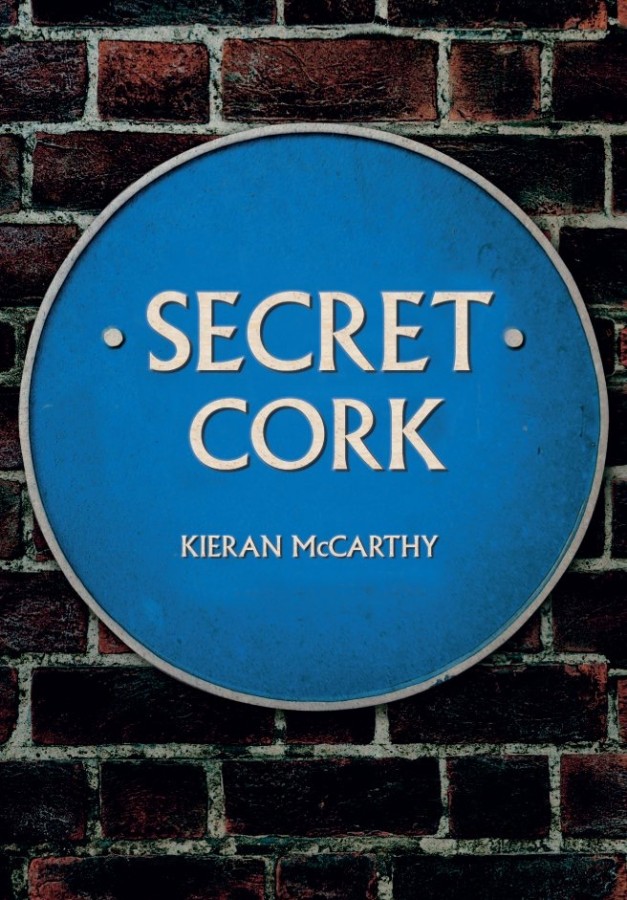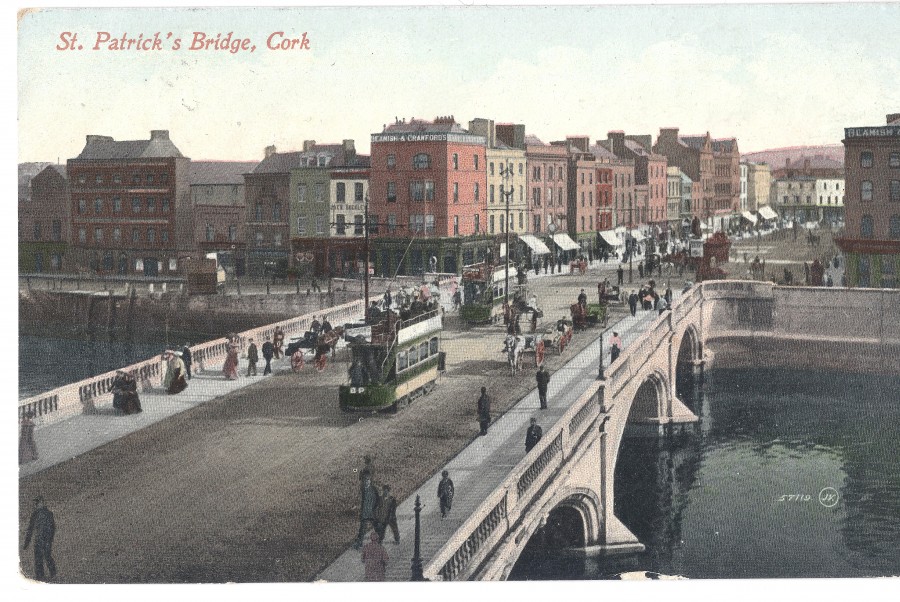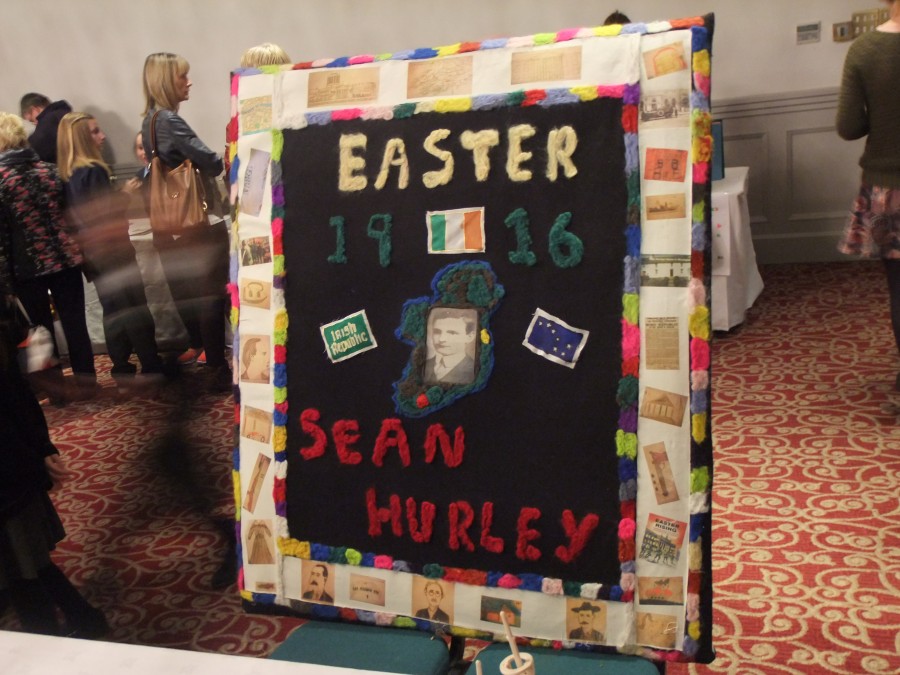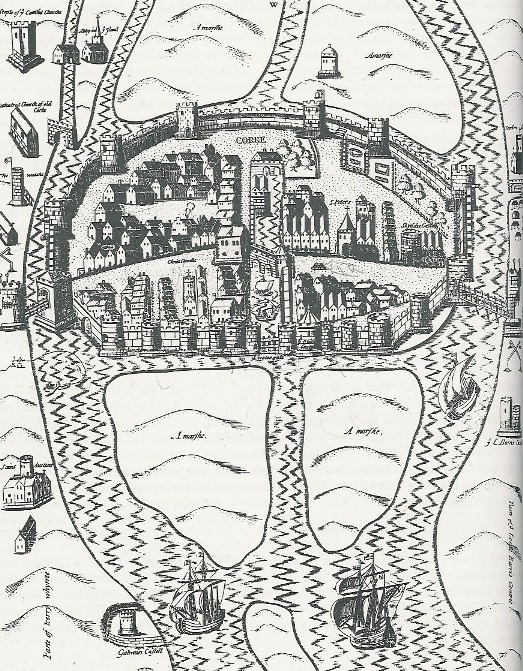Kieran’s Our City, Our Town, 7 April 2016
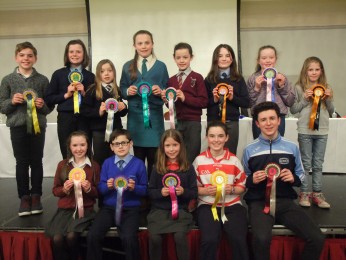
Kieran’s Our City, Our Town Article,
Cork Independent, 7 April 2016
Discover Cork: Schools’ Heritage Project 2016
This year marks the thirteenth year of the Discover Cork: Schools’ Heritage Project co-ordinated by myself. The Project for 2016 recently culminated in two award ceremonies. It is open to schools in Cork City and County – at primary level to the pupils of fourth, fifth and sixth class and at post-primary from first to sixth years. A total of 44 schools in Cork took part this year. Circa 1200 students participated in the process and approx 200 projects were submitted on all aspects of Cork’s history.
One of the key aims of the project is to allow students to explore, investigate and comment on their local history in a constructive, active and fun way. The emphasis is on the process of doing a project and learning not only about your area but also developing new personal skills. Many of the topics in the city such as Shandon or UCC have a myriad of history books written on them. However, the challenge in this project is to get students to devise methodologies that provide interesting ways to approach the study of local history for up-and-coming generations. Submitted projects must be colourful, creative, have personal opinion, imagination and gain publicity. These elements form the basis of a student friendly narrative analysis approach where the students explore their project topic in an interactive way. In particular students are encouraged to attain primary material through engaging with a number of methods such as fieldwork, interviews with local people, making models, photographing, cartoon creating, and making short films of their study topic.
Students are to experiment with the overall design and plan of their projects. It attempts to move the student to become more personal and creative in their approaches. Much of the work could be published as local heritage / history guides to people and places in the region. For example, a winning class project from Cork Educate Together on Grattan Street this year focussed on the history of 1916 in Cork City Centre researched it, mapped out its legacies through interviewing local people and even added in their own mixed family history to add to the complexity of the 1916 narrative. Light was shone on lesser commemorated volunteers who fought in Dublin in the Rising – for example born in 1887, near Drinagh, Sean Hurley was the only Corkman who died in or was executed for his participation in the 1916 Easter Rising. In literature about Michael Collins you will see Sean’s name. Sean’s sister Kate was Michael’s sister-in-law; she was the first wife of Michael’s oldest brother Johnny Collins. To commemorate the memory of Sean Hurley and his fallen comrades, a day of celebration and remembrance, in their honour will be held in Drinagh, County Cork, 1 May 2016.
This year marks went towards making a short film or a model on projects to accompany history booklets. Submitted short films this year had interviews of family members, neighbours to local historians to the student taking a reporter type stance on their work. Some students also chose to act out scenes from the past. Students from Our Lady of Lourdes National School, Ballinlough this year composed a rap song on the story University College Cork.
The creativity section also encourages model making. The best model trophy in general goes to the creative and realistic model. Models of Cork City Gaol and St Anne’s Church, Shandon featured this year in several projects – not only physical models but Minecraft digital models as well.
Every year, the students involved produce a section in their project books showing how they communicated their work to the wider community. It is about reaching out and gaining public praise for the student but also appraisal and further ideas. Some class projects were presented in nursing homes to engage the older generation and to attain further memories from participants. Students were also successful in putting work on local parish newsletters, newspapers and local radio stations and also presenting work in local libraries. This year the most prominent source of gaining publicity was inviting the public into the classroom for an open day for viewing projects or putting displays on in local GAA halls, credit unions, community centres and libraries.
Overall, the Discover Cork: Schools’ Heritage Project attempts to provide the student with a hands-on and interactive activity that is all about learning not only about your local area but also about the process of learning by participating students. The project in the city is kindly funded by Cork Civic Trust (viz the help of John X Miller), Cork City Council (viz the help of Heritage Officer Niamh Twomey), the Heritage Council with media support from the Evening Echo as well. Prizes were also provided in the 2016 season by Lifetime Lab, Lee Road (thanks to Meryvn Horgan), Sean Kelly of Lucky Meadows Equestrian Centre Watergrasshill and Cork City Gaol Heritage Centre. The county section is funded by myself and students. A full list of winners, topics and pictures of some of the project pages for 2016 can be viewed at my website www.corkheritage.ie and on facebook at Cork, Our City, Our Town. For those doing research, www.corkheritage.ie has also a number of resources listed to help with source work.
Captions:
838a. Representatives of the County schools involved in the Discover Cork: Schools’ Heritage Project 2016 at the recent award ceremony in Silversprings Convention Centre (picture: Yvonne Coughlan)
838b. Tapestry from Derryclough NS, Drinagh commemorating the life of 1916 Rising participant, Sean Hurley (picture: Kieran McCarthy)
Happy Christmas

Happy Christmas to everyone, time to slow down and enjoy
Kieran’s Our City, Our Town, 8 January 2015
Article 774 –8 January 2015
Cork Harbour Memories (Part 5) –Tales of Two Cities
With the Irish Channel being a type of maritime motorway in its day, the connection between Cork and Bristol was close during the early thirteenth century. I think sometimes, we view the historic development of Irish cities as self contained but settlements such as Cork have always drawn on ideas of place making put forward elsewhere in western Europe.
Continuing on from just before Christmas, in the early 1200s, the number of religious and charitable establishments in Bristol and Cork grew rapidly. From the earliest times of the Anglo-Norman conquest of England and of Ireland, they were interested in exercising control over the Church (for use in assimilation purposes and for its land). General history books in Bristol library such as Peter Aughton’s book, Bristol, A People’s History (2003), detail that a Dominican Priory was established in 1227-9 while a Franciscan Priory in 1234. Both were founded to the influence of Anglo-Norman family of Berkely who possessed territory near St. Mary’s Church, Redcliffe. Other church associated institutions established at the time included St Mark’s Hospital, St Bartholomew, St Lawrence, St John’s Hospital for sick poor, St Catherines, St Mary Magdalene for lepers And Brighbow for male lepers located outside the town’s eastern boundaries.
In 1250s, the order of Augustinians was founded near Temple Gate while in 1267 a Carmelite Friary was founded. In Cork, a Dominican and Franciscan Friary were both established in 1229 while an Augustinian abbey was founded much later between the years 1275 and 1285. The Cork establishments still have very elaborate and beautiful churches in our city.
In Bristol, the early 1200s marked conflict between the Berkelys of Redcliffe and the civic administrators over accessibility to the town. The Berkelys felt that they were discriminated against. Consequently in 1239, a new bridge was built which connected Redcliffe to the walled settlement. By 1247, the Redcliffe area became part of the town when it was walled in. In addition, a new harbour was dug at the junction of the River Froom and the larger River Avon. Between 1275 and 1300, Bristol’s seal or Coat of Arms was created, Bristol castle with a ship seeking refuge under its gates and walls and a sailor. My own gut is that Cork’s coat of arms is linked to Bristol’s one. I cannot prove it with historical detail but the close links and similar culture of development between the two cities do point to it.
The late thirteenth century coincided with Cork expanding rapidly as a municipal centre. In 1273, the first Mayor named Richard Wine was appointed. This was a sign that Cork was taking its place amongst other up and coming English settlements. As a city we are also lucky that historical developments of the thirteenth century have survived the test of time. Concerning trade links, the oldest and richest in historic research and detail is the insightful Economic History of Cork by William O’Sullivan (1937). The historical evidence describes that the port at Cork was a wealthy earner. The customs returns of Irish ports in the period 1276 to 1333 show that Cork was the third most important port in Ireland, after New Ross and Waterford and that it was estimated that Cork possessed 17 % of total Irish trade. In addition, it is recorded that the main export duties were paid on wool, wool-fells and hides. These figures highlight Cork’s growth as a premier North Atlantic port.
In 1284, the townscape of Cork’s walled settlement was critiqued by King Edward I. He authorised the collection of additional murage tolls or taxes on the land so that walls of the southern island i.e. around South Main Street area could be improved. He described the bridges of the town to be ruinous and the port as being so deteriorated that a swift response was needed to revamp it. The monarch also detailed that there was a vacant place, Dungarvan or the northern island, which should be built on and that it would be of great advantage to the citizens of the town. In time this area was built upon and North Main Street emerged.
In 1317, paving and the repairing of facets of Bristol’s walled town began. In the same year in Cork it was decided to enclose with stone walls, the southern and the northern island (Dungarvan) of Cork. Hence a 16 acre settlement site across two marshy islands was created. Access into this town was via three entrances – two drawbridges and an eastern portcullis gate which lifted up and down on water. A channel of water was left between both islands; the western half was dominated by a millrace, the eastern half by an interior dock within the walled town.
As the thirteenth century progressed, commercial leaders in Bristol and Cork began to hold chief places in civic government. For example John de Bristol became Mayor of Cork in 1336. After the extension of the wall circa 1300, several taxes are listed in subsequent royal charters granted to the city which refer to numerous traded articles. In the thirteenth century, Bristol was to open up trade with France in the form of the Gascony wine trade. Subsequently links between Ireland and other French ports through Bristol’s contact grew steadily.
To be continued…
Happy New Year to all readers of this column
Caption:
774a. Pacata Hibernia view of the walled town of Cork, c.1575 (source: Cork City Library)
Blackrock Harbour Square and Park Project
Cork City Council proposes to redevelop the public realm in the vicinity of Blackrock Harbour. The project aims to build on Blackrock’s unique character as an urban village centre and enhance its potential for increased levels of business, recreation and leisure activity.
The project aims to improve the public realm and create a safe, open and attractive pedestrian space. A Public Park will be created within the Ursuline grounds with access provided from Blackrock Road and Church Road. Traffic calming measures will be installed to promote appropriate vehicle speeds. Traffic and parking lanes will be rationalised and new street furniture, lighting etc will be provided.
Particulars of the proposal will be available for inspection at the:-
Reception Desk, Cork City Council, City Hall, Cork from Friday, 28th June 2013 until Monday, 12th August 2013, between the hours of 9.00am and 4.00pm, Monday toFriday.
Submissions and observations dealing with the proper planning and sustainable development of the area in which the proposed development is situated, may be made in writing in an envelope clearly marked “Blackrock Harbour Square and Park Project” to the Roads Design/Construction Division, Room 331, City Hall, Cork, before 4.00pm on Monday, 26th August 2013.
NOTICE UNDER PART VIII (
McCarthy’s Walking Tours, June 2013
Kieran McCarthy’s summer walking tours of Cork City centre will take place during the month of June, on Tuesday evenings (18th, 25th). The tours begin at the National Monument on the Grand Parade, at 7pm on those evenings and explore the City Centre’s early development on a swamp. The tour costs e.10 per person and children under 12 are free. No booking is required, just turn up on the evening. Further information, if needed, can be attained from Kieran at 0876553389.
On Saturday, 22 June, the Friends of St Finbarr’s Hospital will be holding its annual garden party from 1.30 to 4.30 pm. As part of a whole series of events planned, Cllr Kieran McCarthy invites the general public to take part in a historical walking tour of St. Finbarre’s Hospital at 12noon. (meet at gate; the event is free as part of Cllr McCarthy’s community work). The workhouse, which opened in December 1841, was an isolated place – built beyond the toll house and toll gates, which gave entry to the city and which stood just below the end of the wall of St. Finbarr’s Hospital in the vicinity of the junction of the Douglas and Ballinlough Roads. The Douglas Road workhouse was also one of the first of over 130 workhouses to be designed by the Poor Law Commissioners’ architect George Wilkinson.
To mark the day of the actual fiftieth anniversary of John F Kennedy receiving the freedom of the city and taking off by helicopter from what is now Kennedy Park, Cllr Kieran McCarthy’s tour of Cork Docklands will take place on Friday, 28 June leaving at 7pm from Kennedy Park, Victoria Road (free, 1 1/2 hours). Some of the themes covered in the talk will be John F Kennedy’s visit to Cork and the development of the areas surrounding Albert Road and the Docklands itself.
Kieran’s Motions and Question to the City Manager, Cork City Council Meeting, 15 May 2012
Question to the City Manager:
To ask the manager for a breakdown of the expenses incurred on (a) the curtains around the Council Chamber, (b) the cost of research, and framing the photographs outside the Lord Mayor’s office and (c) the cost of research, and framing of the former Lord Mayor’s portraits in the former City manager’s office in the Lord Mayor’s Room (Cllr Kieran McCarthy)
Motions:
To repair the road from the start of Burke’s Hill, Lotamore to the GAA Pitch in Mayfield (Cllr Kieran McCarthy)
That the Council consider the introduction of legislation to support complaints about high hedges not being cut back to sustainable levels/ heights/ widths in private estates. In the UK Part 8 of their Anti-social Behaviour Act 2003 allows for their Councils to mediate between parties whose hedges and trees have overgrown and are affecting the house next door in several ways. The UK documentation on High Hedge legislation is at the following link, http://www.communities.gov.uk/documents/planningandbuilding/pdf/highhedgescomplaining.pdf (Cllr Kieran McCarthy)

Kieran’s Our City, Our Town Article, 16 February 2012
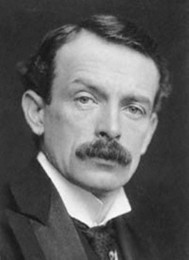
Kieran’s Our City, Our Town Article
Cork Independent, 16 February 2012
Technical Memories (Part 6)
A Meeting with Lloyd George
Shortly after a technical instruction committee was formed in Cork in 1899, a deputation, who after viewing technical institute buildings in England, reported strongly in favour of constructing one in the city. The proposed structure was to house the science and technology classes and the art and craft classes being already provided for. It was not until November 1907, did the committee found its income somewhat healthy to discuss in detail a proposal for a building. It was hoped that more substantial funding would be attained from the Chancellor of the Exchequer in Westminster at the time, David Lloyd George.
On the 28 June 1908, the Irish Independent reports Dr. Bertram Windle attended a meeting with Lloyd George in London to pitch the case for extra funding for technical education in Ireland. Lloyd George had just been in this job since mid April and was hoping to introduce state financial support for the sick and infirm through raising higher taxes and reducing military expenditure. Bertram Windle was part of a deputation representing the Standing Committee on Technical Education in Ireland who was aware of the proposed financial reforms.
In introducing the deputation, John Redmond, MP for Waterford, explained that although it was a small one, it represented “universal opinion” in Ireland as to the requirements for technical education. The deputation claimed unless a grant in some way was made by the Treasury in aid of technical education, then the great deal of money already spent in Ireland would be wasted. Bertram Windle told the Chancellor that compared to Britain, Ireland had not had a satisfactory industrial past. However, he thought that anyone who visited the Franco-British Exhibition and who examined the exhibits produced under the aegis of the Department of Agriculture and Technical Instruction would come to the conclusion that technicali had made great progress in Ireland.
The Exhibition, Bertram Windle referred to, was a large public fair held in London in 1908. The exhibition attracted 8 million visitors and celebrated the Entente Cordiale signed in 1904 by the United Kingdom and France. The signing of the Entente Cordiale marked the end of almost a millennium of intermittent conflict between the two nations and their predecessor states, and the formalisation of the peaceful co-existence that had existed since the end of the Napoleonic Wars in 1815.
The Irish work exhibited at the exhibition was as good according to Bertram Windle as that produced in English schools. The movement, he argued, was hampered in Ireland by the deficit of buildings, and he gave as examples the difficulties experienced in Cork and Kilkenny. Wexford, noted Bertram Windle, was the only place where real genuine engineering manufactories were growing, “exactly the sort of place that should be encouraged to have technical education”. He pointed out that their technical schools were carried on under adverse conditions; the extant buildings were unsanitary and unsuitable.
The argument might be used, Windle said, “why did they [government] not build suitable schools in Ireland?”. He noted that the rateable value of the country prevented it, and he compared Cork and Birmingham, the latter with a penny rate producing £6,000, while Cork only produced £700. Under existing conditions in Ireland, they must either have a school and no teachers or no teachers and an imperfect school. Ireland, Bertram Windle claimed, only wanted a fair start, and he appealed to the Chancellor for a certain sum per annum, with which they could make the technical movement in Ireland an enormous success.
Mr. E.J. Long, High Sherriff of Limerick City, pressed the points from the Limerick view, where in the previous year they had to turn away a large number of students, because of insufficient accommodation, owing to lack of funds. Mr. Forde of Belfast emphasised the claims put forward, speaking on behalf of the North of Ireland generally. If the treasury, he proposed, allocated £20,000 per annum for a term of years to technical instruction in Ireland, “the questions would be placed on a more satisfactory footing”.
The Chancellor of the Exchequer, Lloyd George, in response noted that it was not altogether accurate to say the Ireland had got nothing towards technical education prior to 1899. There was a grant in 1889 of which there was no corresponding grant to England, Scotland, or Wales. He did not wish to make a point out of that, but at the same time he could not recognise that there were arrears due to Ireland in the matter. He noted that there were many demands for investment into Ireland, demands for afforestation programmes, Congested District programmes, housing, and the Irish university question. The deputation, he told them, should not press for a final and definitive answer as all concerns were being examined at that moment in time.
The request for funding the creation of better technical colleges in the country was not met. In the Cork context, after a discussion with T.W. Russell, the Vice-President of the Department of Agriculture and Technical Instruction, the Cork committee found themselves in mid 1908, in a position to ask the Corporation of Cork for a loan of £16,000.
To be continued…
Caption:
628a. Photograph of David Lloyd George, Chancellor of the British Exchequer, c.1907 (source: Cork City Library)
Kieran’s Our City, Our Town, 13 October 2011
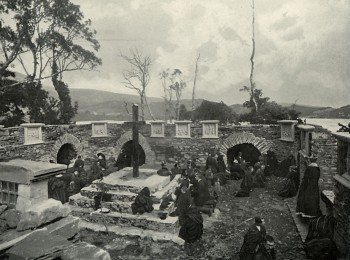
Kieran’s Our City, Our Town Article,
Cork Independent, 15 October 2011
In the Footsteps of St. Finbarre (Part 270)
The Reworking of Memories
On my perch next to the main set of cells in Gougane Barra, many come looking for the old money tree. For many years, the remains of an old cross stood alongside the tree. This may have the cross that Fr Patrick Hurley, the Parish Priest commissioned in the early 1900s. The cross, which was made of yew from Ardmore, was erected by Mr. Buckley of Youghal and had on it in three languages – English, Latin and Irish, on an enamelled plate, the following inscription, “Here stood in the sixth century the cell of St Finbar, first Bishop of Cork”. This cross for many years in the twentieth century also had coins stuck in it and was replaced in recent years by the present cross.
Fr Hurley in the first decade of the 1900s also pursued some work on Father Denis O’Mahony’s tomb, which he notes in 1892 in his article in the Journal of the Cork Historical and Archaeological Society, as very much neglected. On taking off the old flagstone covering it, he discovered an inscription on it (and was nearly obliterated) of a beautifully-carved limestone cross, from a model of one in St Mary’s Church, Youghal, County Cork. He got the stone inscribed with a cross, chalice and host. Portions of the coffin, made of black oak, in the tomb were opened. The bones were carefully collected and placed in an oak case with a suitable inscription.
On the pilgrimage island Fr Hurley commissioned a memorial in memory of J.J. Callanan, poet, author of the poem Gougane Barra, and noting on the inscription “Born in Cork AD 1795. Died in Lisbon, where he is buried, the 15th September 1829 – RIP”. Jeremiah Joseph Callanan (1795–1829) was an Irish poet born in County Cork, Ireland. Callanan studied for Catholic priesthood at Maynooth College, and afterwards law at Trinity College, Dublin, where he won two prizes for his poems. Afterwards, he found employment teaching briefly at a school in his hometown of Cork. Callanan also contributed translations of Irish verse to Blackwood’s Magazine, which was run by another promoter of Irish literature, Dr William Maginn. For four years up to 1827 Callanan spent much of his time going around Cork and the south west of Munster collecting old ballads and legends and having them translated and published. One of his most famous translations was that of an Irish poem on Gougane Barra (translated to Gougane Barra). In 1827 he travelled to Lisbon to work as a tutor in 1827. He died in Lisbon in 1829 as he was preparing to return to Ireland.
In an article in the Irish Independent in 1905, Fr Hurley reveals his strategy for social improvement amongst the people of the surrounding region. He noted that on his arrival he found the Irish language on the point of going. He discouraged this, and in the schools, and from the altar he impressed on the local people “the beauty of their own language [Irish]”. Fr Hurley’s work was part of a larger revival in Gaelic culture in Ireland at that time. In 1893 Douglas Hyde played the leading role in the foundation of the Gaelic League. The purpose of the league was to revive the disappearing culture and traditions, and its work stimulated considerable popular enthusiasm for the study of the Irish language. In particular the Catholic Church played a large role in attending League meetings and promoting the Irish language. This is apparent in the myriad of articles, which record their contribution in the Cork context at least in the Cork Examiner from the early years of the 1900s.
In addition in an attempt to encourage the use of the Irish language in schools, Fr Hurley made the acquaintance of Rev Richard O’Daly, a priest of a diocese of Goulbourne, Australia, who made his studies at the College of Propaganda, Rome. He had an opportunity there of studying languages from his contacts with students from all nations, and subsequently travelled through Europe, where he acquired a knowledge of nearly every European language. Born in Australia, but with parents from the Ballingeary area, he wished to learn the Irish language. He began learning at the Gaelic League classes in London, where for a short time he did missionary work. Coming to Ballingeary, he perfected his knowledge of Irish, and Fr Hurley secured his services to serve the pilgrims coming to pray at Gougane Barra.
In the summer of 1903 Fr Daly invited Irish scholars to Ballingeary from several parts of Ireland. This was the start of the Irish college in the region. In the autumn of 1903, at a “Feis” at Ballingeary, a village four miles from Gougane Barra, Father Goulding, of New Zealand, offered an annual subscription towards an Irish College at Gougane Barra. The London Gaelic League and the Dublin branches also subscribed. It was found the accommodation at Gougane Barra was too limited, and it was arranged to have the Irish college opened in Ballingeary, where there was a good hall for lectures, excellent schools where the children were Irish-speaking, and places where lodgings could be had in the immediate area.
To be continued…
Captions:
612a. Pilgrims, Gougane Barra, Co. Cork, c.1900 (pictures: Ebay postcards)
612b. Pilgrims, Gougane Barra, Co. Cork, c.1920 (growth has returned to the previously cleaned walls of the cell complex).
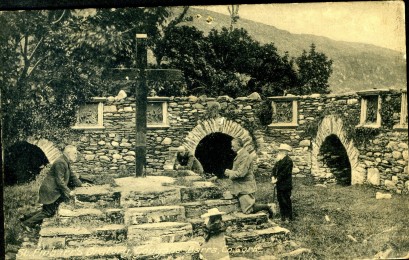
Kieran’s Response to the Savings of c.2m euros to be cut from Council Budget, Cork City Council Meeting, 26 September 2011
Lord Mayor, once again, we need to tighten the control rein on our finances – plus perhaps we need to critique what we have adapted in the Capital Works account such as the City Hall revamp. That we didn’t see these financial problems arise until now is short-sighted.
In addition, this report shows the poor state of the country’s finances. The drop in the collection of rates also shows that traders in the city are suffering, are as traders right across the country. The more we continue to do and we can do to stimulate trade the better for all. I would like to call on the government parties in the Council Chamber to relay the report back to the Cabinet.
